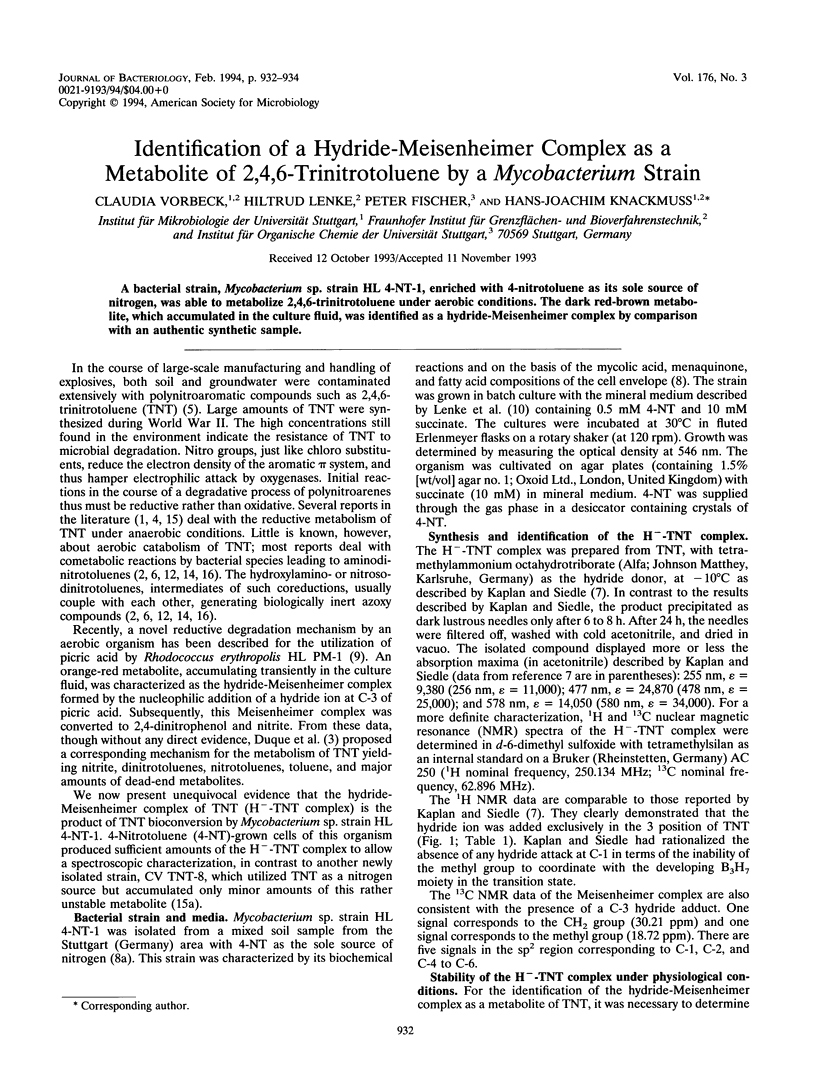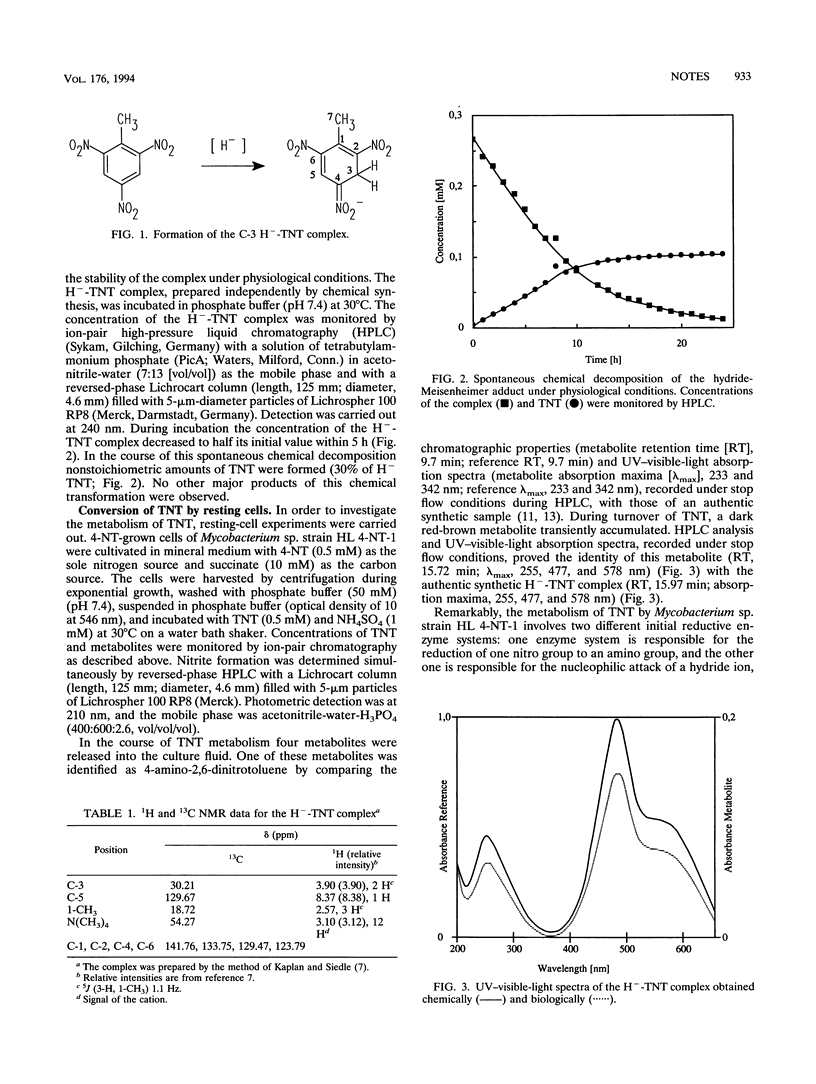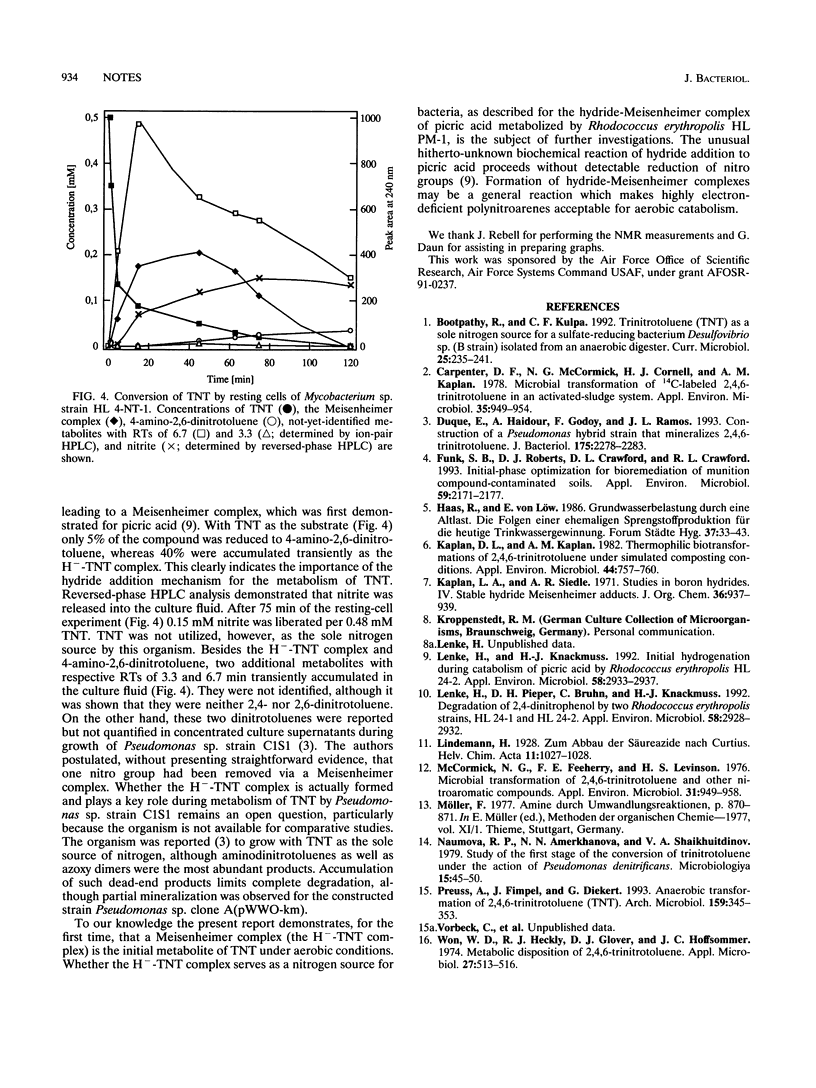Abstract
A bacterial strain, Mycobacterium sp. strain HL 4-NT-1, enriched with 4-nitrotoluene as its sole source of nitrogen, was able to metabolize 2,4,6-trinitrotoluene under aerobic conditions. The dark red-brown metabolite, which accumulated in the culture fluid, was identified as a hydride-Meisenheimer complex by comparison with an authentic synthetic sample.
Full text
PDF


Selected References
These references are in PubMed. This may not be the complete list of references from this article.
- Boopathy R., Kulpa C. F. Trinitrotoluene (TNT) as a sole nitrogen source for a sulfate-reducing bacterium Desulfovibrio sp. (B strain) isolated from an anaerobic digester. Curr Microbiol. 1992 Oct;25(4):235–241. doi: 10.1007/BF01570724. [DOI] [PubMed] [Google Scholar]
- Carpenter D. F., McCormick N. G., Cornell J. H., Kaplan A. M. Microbial transformation of 14C-labeled 2,4,6-trinitrotoluene in an activated-sludge system. Appl Environ Microbiol. 1978 May;35(5):949–954. doi: 10.1128/aem.35.5.949-954.1978. [DOI] [PMC free article] [PubMed] [Google Scholar]
- Duque E., Haidour A., Godoy F., Ramos J. L. Construction of a Pseudomonas hybrid strain that mineralizes 2,4,6-trinitrotoluene. J Bacteriol. 1993 Apr;175(8):2278–2283. doi: 10.1128/jb.175.8.2278-2283.1993. [DOI] [PMC free article] [PubMed] [Google Scholar]
- Funk S. B., Roberts D. J., Crawford D. L., Crawford R. L. Initial-phase optimization for bioremediation of munition compound-contaminated soils. Appl Environ Microbiol. 1993 Jul;59(7):2171–2177. doi: 10.1128/aem.59.7.2171-2177.1993. [DOI] [PMC free article] [PubMed] [Google Scholar]
- Kaplan D. L., Kaplan A. M. Thermophilic biotransformations of 2,4,6-trinitrotoluene under simulated composting conditions. Appl Environ Microbiol. 1982 Sep;44(3):757–760. doi: 10.1128/aem.44.3.757-760.1982. [DOI] [PMC free article] [PubMed] [Google Scholar]
- Lenke H., Knackmuss H. J. Initial hydrogenation during catabolism of picric acid by Rhodococcus erythropolis HL 24-2. Appl Environ Microbiol. 1992 Sep;58(9):2933–2937. doi: 10.1128/aem.58.9.2933-2937.1992. [DOI] [PMC free article] [PubMed] [Google Scholar]
- Lenke H., Pieper D. H., Bruhn C., Knackmuss H. J. Degradation of 2,4-dinitrophenol by two Rhodococcus erythropolis strains, HL 24-1 and HL 24-2. Appl Environ Microbiol. 1992 Sep;58(9):2928–2932. doi: 10.1128/aem.58.9.2928-2932.1992. [DOI] [PMC free article] [PubMed] [Google Scholar]
- McCormick N. G., Feeherry F. E., Levinson H. S. Microbial transformation of 2,4,6-trinitrotoluene and other nitroaromatic compounds. Appl Environ Microbiol. 1976 Jun;31(6):949–958. doi: 10.1128/aem.31.6.949-958.1976. [DOI] [PMC free article] [PubMed] [Google Scholar]
- Preuss A., Fimpel J., Diekert G. Anaerobic transformation of 2,4,6-trinitrotoluene (TNT). Arch Microbiol. 1993;159(4):345–353. doi: 10.1007/BF00290917. [DOI] [PubMed] [Google Scholar]
- Won W. D., Heckly R. J., Glover D. J., Hoffsommer J. C. Metabolic disposition of 2,4,6-trinitrotoluene. Appl Microbiol. 1974 Mar;27(3):513–516. doi: 10.1128/am.27.3.513-516.1974. [DOI] [PMC free article] [PubMed] [Google Scholar]


